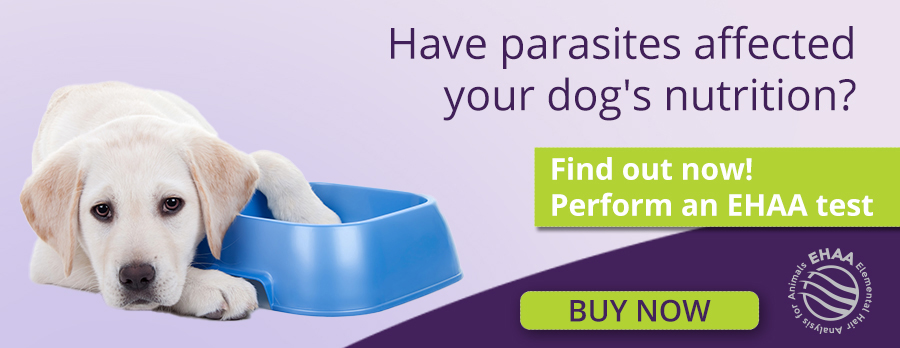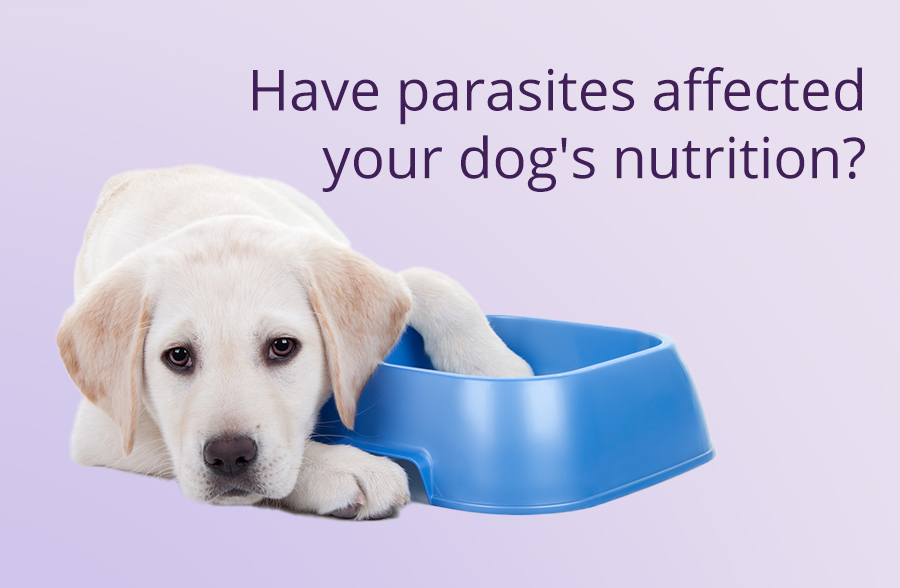Parasites and worms in dogs are quite common ailments. Any dog can have worms, even those that are mainly taken for walks on a leash. Most often, however, they tease those animals that often run around freely and may encounter rodents or feces of other carriers, as well as with stray dogs. It should be remembered that the problem of parasites and worms in a dog does not only affect the quadrupeds themselves, but also poses a serious threat to humans.
Internal parasites and worms in a dog
Endogenous or internal parasites in a dog can be divided into several groups, depending on the place where they live within the host, the most important are:
- intestinal parasites (roundworms, hookworms, whipworms, and tapeworms)
- and parasites not found in the gut (heartworms, lungworms, subcutaneous and eye nematodes).
We can also divide animal parasites by their shape. In this case, we divide them into:
- roundworms, the so-called roundworms (including roundworms, nematodes, whipworms, hookworms)
- and flatworms (which include canine tapeworm, spirochetal tapeworm and echinococcal tapeworm).
Only some parasitic infections are closely related to the age of the animal, most often the risk is lifelong. Therefore, it is essential for every dog owner to implement the correct parasite control measures throughout their pet’s life – worms are dangerous both for puppies and adults. If a specific parasitic infestation is diagnosed, the infested dog should receive appropriate treatment as soon as possible, followed by appropriate measures to prevent the return of parasites.
Worms in the dog’s stool and the danger to the environment
Freshly excreted worms in a dog’s poop in developmental stages are invasive once they enter the environment, so proper handling of the faeces is recommended. These should be removed daily and should not be flushed down the toilet or placed in compost. Infection of intermediate hosts (birds, rodents, slugs, or snails) may contribute to extending the survival time of the parasite in the environment. Therefore, use caution when unleashing your pet and follow the cleaning up of animal waste, especially in urban areas. Dog worms are dangerous, especially tapeworm eggs and nematodes, which are highly resistant to environmental factors and can survive in the soil for months or even years.
Therefore, among others, playgrounds for children should be properly fenced to prevent animals from entering their premises, so that the worms in the dog’s stool will not endanger anyone’s health. Sandboxes should be covered – the sand, especially when left uncovered, is at risk of being contaminated with faeces. It should also be replaced regularly, at least once or twice a year. Drying out and ultraviolet rays destroy the eggs and worms in your dog’s poop, so allowing the contaminated area to be exposed to sunlight and drying out can be helpful in reducing the level of contamination.
How to recognize parasites, worms in a dog – symptoms
If your dog has had parasites, the symptoms should signal the pet’s infection. Depending on what worms appeared in the dog, the symptoms will also be different – on their basis, we can initially determine which parasite has attacked the quadruped. It may happen that your dog has various parasites and larvae that systematically destroy its body. The symptoms are not always as obvious as when the dog expels the roundworms and vomits the worms. Parasites in dogs cause lethargy, make them avoid contact, they constantly want to sleep, they suffer from vomiting and diarrhea (which sometimes has blood), strange cough, heavy breathing, may cause irritation around the anus, problems with its fur becoming dull and falling out. A dog’s helminthiasis and parasite infection can also manifest as a lack of appetite and significant weight loss, as well as notorious rolling on the floor due to the itchy back.
It locates in the small intestine and can lead to the development of various diseases, among which the most dangerous is toxocarosis. The fact that the dog has roundworms can be recognized by the fact that it suffers from diarrhea, is thinning, coughing, is lethargic, and its coat becomes weak and falls out. In puppies, the first deworming should be carried out with an appropriate antiparasitic drug already in the second week of the puppy’s life. As parasites in a puppy are very dangerous, further deworming should be performed regularly every 14 days until the second week after weaning, and then monthly until the age of six months. Lactating females should be given the anthelmintic drug at the same time when their offspring are first given the drug. Dogs can also become infected with roundworm at an older age but are very rarely associated with clinical signs. As a result, it is difficult to determine if a dog is having roundworms unless it has been regularly tested to find parasites in dog feces.
Increasing the frequency of deworming in adult dogs has been shown to be effective in reducing the incidence of infected animals. The results of the research carried out indicate that deworming four times a year does not necessarily eliminate invasions, while monthly therapy can largely prevent the development of infections. In cases of increased risk (such as in animal farms or homes with children), monthly worming can significantly reduce the risk of developing parasite infestation and egg shedding. An alternative to repeating the deworming therapy may be to perform a faecal examination at appropriate intervals, i.e., every month or every three months.
These parasites live in the intestine, where they excrete waste products, poisoning the dog’s body or even closing the intestinal lumen. What does a tapeworm look like in a dog and what happens if a dog has these parasites? Intestinal parasites in a dog may be suspected if the dog is vomiting, has alternating diarrhea and constipation, and has mucus in sparse faeces. Symptoms of infection are also unsteady gait and epileptic seizures. The larval stage of tapeworms poses a major threat to public health. In humans, depending on the species, tapeworm causes hydatidosis (single-chamber echinococcosis) and alveococcosis (multi-chamber echinococcosis), which, if left untreated, can be fatal.
Both invasions result in the formation of cysts, most often in the liver. Tapeworm eggs, immediately after excretion by the definitive hosts, are fully invasive to intermediate hosts, including humans. In cases where animals are infected, it is recommended that they be treated under the supervision of a veterinarian with effective anthelmintics, and dogs should be shampooed to remove the parasites from their eggs. Remember that what a tapeworm looks like in a dog and the course of treatment of an animal depends on the stage of development of the parasites, and only a comprehensive action will allow you to remove both the larvae in the dog’s body and the worms in the dog.
The spread of heartworms is favored by climate change, and the increasing number of pets travelling with their owners increases the risk of infection in dogs. Currently, there are no repellent or insecticidal agents that are shown to be effective in preventing the transmission of heartworms. Therefore, preventing infection in dogs depends on the use of drugs that prevent the development of nematodes by eliminating juvenile forms before they can travel to the heart. With the use of appropriate preparations, it is possible to effectively prevent the development of nematode infestation in the dog. Puppies should receive preventive treatment against heartworms as soon as possible after birth.
The second type of this parasite is the dog’s subcutaneous nematode. What happens when dogs have these parasites? Although in this case most of the infestation is asymptomatic, we can observe these worms on the dog – in the skin of infected animals, cold, non-painful nodules with adult parasites can be found. In severe infections or in allergic animals, the worm infection can lead to mild to severe dermatitis.
Hookworm infection in a dog is manifested by lack of appetite, vomiting, emaciation, unformed faeces, pale mucous membranes, anemia, shortness of breath and breathing problems. This parasite also causes lethargy.
The most common symptom of infection with this parasite is chronic, bloody diarrhea, which gradually destroys the body, and the worms in the dog’s stool can also damage the intestines. The dog may also lose weight, develop a fever and be weak.
The above-mentioned parasites are only a few of the many that can occur in the dog’s body and threaten not only its health, but also the health of people around it.
Health effects on the dog
Parasites, as the name suggests, benefit from being in the dog’s body, and the animal suffers damage. The harmful effect is mainly due to the parasite taking up the necessary nutrients for the dog, which can lead to serious deficiencies, and in the case of puppies, to impaired growth and development. After effective deworming, it is worth checking which minerals necessary for health are missing in our friend’s body and replenish them.
Parasites in a dog deal with all their needs, including the excretion of toxic metabolic products, directly into the organism of their host, which poisons the quadruped and may lead to diseases, especially the digestive system, as well as causing allergies. The presence of parasites also provokes the immune system, which, instead of protecting the animal from bacteria and viruses, fights parasites, which makes the animal more susceptible to various infections.
An animal infected with the parasite requires care tailored to its individual needs. Some factors may indicate a need for more intensive monitoring and/or treatment, while others may necessitate a less committed approach. Puppies and older animals are at an increased risk compared to healthy adults. The larvae in the dog’s body are especially dangerous in pregnant females as there is a transfer of roundworm larvae to the fetuses. Lactating female dogs can also be a source of parasite infestation for their puppies through milk (lactogenic infection). Dogs that live in kennels, outdoors, with other dogs or cats, and in contact with homeless and hunting dogs are also at increased risk of infection by parasites. For this reason, they also require special treatment.
Dogs have access to rodents, slugs and snails, raw fish, and raw meat, including internal organs, placenta, or aborted fetuses, as well as other dogs that live and travel to specific geographic locations (e.g., during holidays or when moving house) while staying in assembly venues at check-in points before travel, e.g., by plane, shows and competitions.
Have you recognized the symptoms of parasites in your dog? Do something fast!
An owner who suspects parasites in a dog should see a veterinarian as soon as possible, who will prescribe the appropriate treatment. As parasites are common, they cause unpleasant and often severe ailments in the pet and are also a threat to people, deworming should also be performed prophylactically. If there are several dogs in the house and one of them has parasites, all dogs should be cleaned at the same time. Endoparasiticides come in a variety of forms and most contain more than one active ingredient. Deworming dogs can therefore be administered: tablets – have a broad spectrum of activity and work against hookworms, roundworms, whipworms, tapeworms, lamblia, nematodes, suspension – a paste for oral administration is usually prescribed for hookworms, whipworms and roundworms – spot-on preparations are effective in the case of hookworms, roundworms, whipworms and tapeworms. The applicator allows to treat the skin of the animal in which hookworms, roundworms, whipworms, heart or lung nematodes are present.

Health effects on human
Let’s not underestimate the situation if we have recognized the symptoms of worms in a dog – some parasites can also be a threat to humans! Mainly children are exposed to infection, both those who play with an infected dog and those who come into contact with mature roundworm eggs (e.g. in the sand at a playground). When these eggs reach the digestive tract, they hatch larvae, which then pass through the intestinal walls into the bloodstream and continue to various organs, including the lungs, liver, eyeballs, and even the brain, causing inflammation in them.
Hookworms are also a threat to humans – when they penetrate the skin, they can cause its inflammation – as well as tapeworms, especially echinococcosis. The larvae of this tapeworm in the human body settle in various organs, most often in the liver, and turn into cysts that grow over many years, gradually putting pressure on other organs.
People in contact with animals that are capable of transmitting parasitic diseases are at risk, and the degree of risk increases especially in the following cases: immunocompromised people such as the elderly, HIV-positive people, patients undergoing immunosuppressive therapy, organ transplantation or the treatment of autoimmune diseases, pregnant women, children and infants, as well as mentally handicapped people and people with specific professions such as farmers, livestock workers and hunters.
The potential risk related to the parasitic disease does not threaten only animals, but also their families and all people living in their environment. Responsible dog ownership can make some public health issues disappear.
Parasites in dogs and the responsibility of the owner
Important animal parasite prevention measures that should be implemented by the owner include:
- maintaining proper personal hygiene, in particular washing hands after touching the animal and before a meal,
- combating parasite infestations by regularly worming the animal and/or regular parasitological tests,
- wherever possible, preventing contamination by reducing the risk of your pet becoming infected,
- regular removal of animal excrements to reduce the degree of contamination of the environment. Do not throw droppings down the toilet or composters,
- reducing the risk of contact of children with potentially contaminated environments and teaching them to observe personal hygiene, clipping their nails,
- regular brushing of dogs to reduce the risk of contamination of their coat by parasite eggs.
FAQ
- What are the symptoms of parasites in dogs?
Vomiting and diarrhea, blood and worms in stools, lack of appetite, significant weight loss, irritation around the anus, drowsiness, lethargy, avoidance of contact, coughing, difficulty breathing, dull and shedding hair, itchy skin.
- What are the health effects of parasites in dogs?
Nutrient deficiencies, developmental disorders, poisoning and diseases of the digestive system, allergies, weakening of the digestive system and susceptibility to other infections.
Sources:
ESCCAP – European Scientific Counsel Companion Animal Parasites
https://www.esccap.org/uploads/docs/leogcerm_ wormcontrolpolishtranslation.pdf
Hubicz Katarzyna, deworming a dog: are worms in dogs dangerous to humans?
http://www.poradnikzdrowie.pl/zdrowie/zwierzeta-domowe/odrobaczanie-psa-czy-robaki-u-psa-sa-grozne-dla-czlowieka_46241.html














